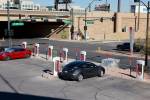NV Energy rebate may not be worth trade involved
One of the most satisfying things we can do is gain energy independence. Start with efficiency. Get a professional energy audit and follow the recommendations, however mundane they may be. Then, it's time for the fun part, installing solar panels.
We all want to save money and get a good deal, especially on big-ticket items. Timing is everything and it is no different when buying a renewable energy system. For photovoltaic systems , the timing is good. Prices are the lowest ever, while efficiency has continued to climb. Incentives are also very strong right now. The two primary incentives are a 30 percent federal tax credit and Nevada's net-metering program.
Another incentive that can help is not available to everyone. I'm referring to NV Energy's SolarGenerations rebate program. For homeowners, the next round of rebates will be valued at $1.35 per watt with a 10,000 watt size limit. Different rules apply for small businesses, schools and public property so check the website for details.
Because the program's tremendous popularity is expected to exceed the available rebate dollars, participants are selected using a lottery process that is under way. The application deadline is Nov. 9. If you are getting ready to add solar to your home in the near future, now is the time to apply for the rebate. Full details can be found at www.nvenergy.com/renewablesenvironment/renewablegenerations/solargen/.
What if you don't win the lottery? Should you wait until next year to try again? Perhaps not. Fortunately, an alternative to the SolarGenerations rebate might be even better in the long run. Keep in mind that if you accept a rebate from NV Energy, you assign your system's Portfolio Energy Credits (PCs) to the utility. This is what they are paying you for, since they can be traded on the market or used to meet their legally required clean energy quota.
Keeping your PCs might be worth it. To illustrate how, I'll use a typical 5 kilowatt PV system as an example. It is a common size for a residential system in Nevada and happens to be the size of the system that provides all the electricity for my home and electric car annually.
Rebate Scenario
Installed prices before incentives are typically in the range of $4 to $6 per watt. We'll split the difference and use $5, starting with a 5,000-watt system price of $25,000. For a rebate lottery winner, the $1.35 per watt rebate takes it down to $18,250. Take the 30 percent tax credit and you're down to $12,775 for a system that could produce nearly $1,400 in yearly energy savings (assuming 11,500 kWh @ .12 cents each) while adding considerable equity to your home.
Assuming a 5 percent yearly utility inflation rate, simple payback occurs in about eight years. Without the rebate, simple payback is extended about two years. If you offset gasoline purchases with an electric vehicle, you can cut that time in half and double your return on investment.
The impact on our environment is priceless, but that is not factored into this exercise.
Alternate Scenario
If you forgo the rebate, your (post-tax incentive) cost is $17,500 but you can trade your PCs (see www.nvtrec.com for details). This is where the area becomes a bit gray since, in Nevada, it seems that the utility determines the schedule, rate and whether or not to make an offer for PCs. However, based on recent practices and pricing, trading your PCs could result in a payback period equal to or better than the rebate scenario above, plus the ongoing revenue. This scenario comes ahead by $2,250 in just two more years. Given a stable market for PCs, it's better to skip the rebate. Changes in legislation or market options could further enhance revenue potential.
One thing is absolutely certain, no matter what option you choose, solar power has become a safe, stable investment that can provide tremendous value. There are certainly no banks paying 20 percent interest. Green living is the way to go. Get going!
Note: The help page on the NVTREC website erroneously states that only systems of 150 kW are tracked. A spokesman at the Public Utilities Commission of Nevada verified that the site is out of date and that any size system can qualify for the program as long as it meets all other requirements.
Steve Rypka is a green living consultant and president of GreenDream Enterprises, a company committed to helping people live lighter on the planet. For more information or to reach Steve, please visit www.greendream.biz.























